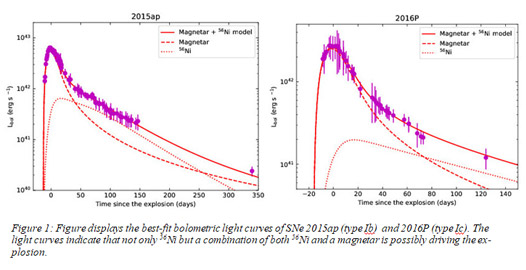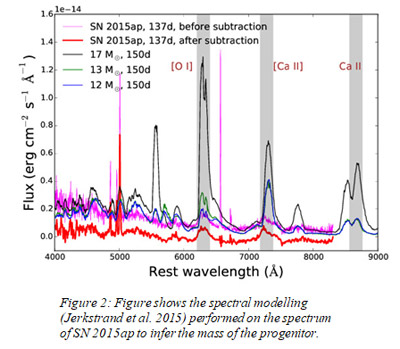 Night skies are always an epitome of tranquility, but the rarer naked-eye Supernovae (SNe: Giant stellar explosions) and Novae (powerful and luminous stellar explosion) discerned that there could be something beyond.
Night skies are always an epitome of tranquility, but the rarer naked-eye Supernovae (SNe: Giant stellar explosions) and Novae (powerful and luminous stellar explosion) discerned that there could be something beyond.
Study of two such stripped-envelope Supernovae (SNe) which have been stripped off their outer enve-lopes of Hydrogen or Helium have given clues to the origin of the giant explosions of these stellar enti-ties that briefly outshines the entire galaxy releasing a huge amount of energy (1051 erg), thereby en-dorsing chemical enrichment.
Scientists of the Aryabhatta Research Institute of Observational Sciences (ARIES), an autonomous in-stitute under the Department of Science and Technology (DST), Govt. of India have found that possible energetics associated with the explosion is not only driven by 56 Ni, but a combination of 56 Ni and a magnetar, a type of neutron star believed to have an extremely powerful magnetic field.
The research lead by Anjasha Gangopadhyay and Kuntal Misra from ARIES which has been recently accepted for publication in Monthly Notices of the Royal Astronomical Society (MNRAS) focuses on two stripped-envelope SNe, a sub-class of core-collapse SNe that strip off their outer envelopes of Hy-drogen or Helium either due to high stellar winds or due to accretion with a nearby companion.
 The study, which involved several other researchers have contributed towards deciphering the physical properties and associated asymmetries of an explosion in two stripped-envelope -- SNe - 2015ap (type Ib) and 2016P (type Ic). These SNe were discovered by the ongoing transient detection surveys in the years 2015 and 2016. The team used high cadence long term photometric and spectroscopic data span-ning a time scale of about 350 days, acquired from several Indian telescopes (1m Sampurnanand Tele-scope,1.3m Devasthal Fast Optical Telescope, and 2m Himalayan Chandra Telescope) and other tele-scopes worldwide (like the 1.82 m Ekar and Copernico telescopes located in Italy). The evolution of these SNe was critically matched and compared with a collective sample of existing stripped-envelope SNe.
The study, which involved several other researchers have contributed towards deciphering the physical properties and associated asymmetries of an explosion in two stripped-envelope -- SNe - 2015ap (type Ib) and 2016P (type Ic). These SNe were discovered by the ongoing transient detection surveys in the years 2015 and 2016. The team used high cadence long term photometric and spectroscopic data span-ning a time scale of about 350 days, acquired from several Indian telescopes (1m Sampurnanand Tele-scope,1.3m Devasthal Fast Optical Telescope, and 2m Himalayan Chandra Telescope) and other tele-scopes worldwide (like the 1.82 m Ekar and Copernico telescopes located in Italy). The evolution of these SNe was critically matched and compared with a collective sample of existing stripped-envelope SNe.
The researchers found out that SN 2015ap is one of the bright types, while SN 2016P, on the contrary, lies at an average brightness. They used the bolometric light curve modelling to arrive at their conclu-sion. They propose that SNe explosions associated with the stripped-envelope group are mostly asym-metric and have a diverse luminosity range. The main powering mechanism could be driven by an ad-ditional energy source like a magnetar in addition to the radioactive sources, and the most favourable progenitor scenario governing the explosions are binary in nature.
According to the ARIES team, “Although the probable progenitors are indicated, and physical parame-ters of explosion are estimated, but an open question on the distinctness or linked by a continuum of properties of such classes of SNe exists. Discovery of more such SNe with upcoming surveys and an in-depth analysis will help in deciphering such hidden questions.”






























